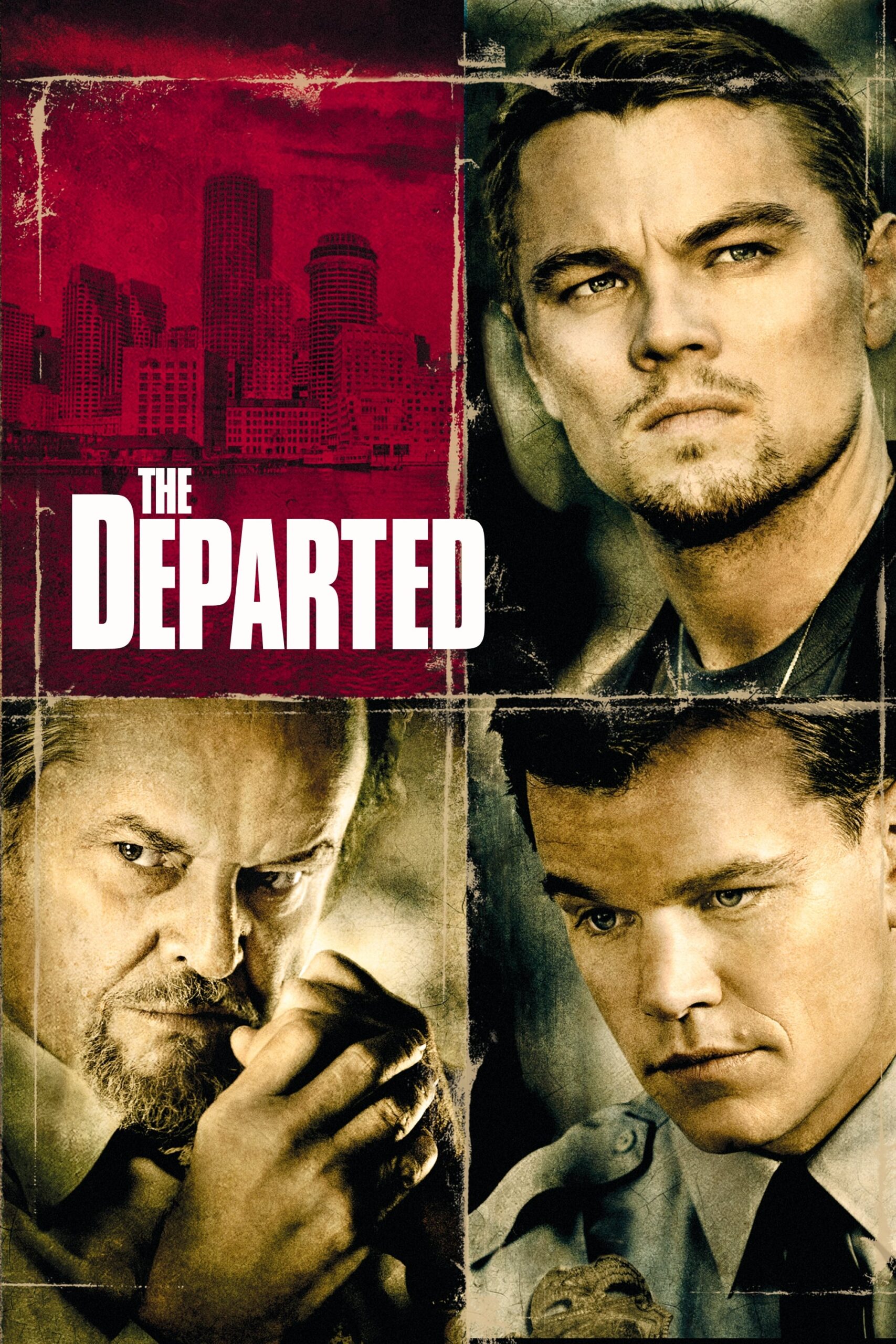Spoilers:
- Everyone dies, including Damon and DiCaprio.
- Jack Nicholson’s mob boss is an FBI informant.
- DiCaprio’s character is a cop undercover.
- Damon’s character is a mole in the police.
- Mark Wahlberg kills Damon in the end.
The Departed: Movie Statistics
A critical look at “The Departed” by Martin Scorsese.
General Information
- Release Date: October 6, 2006
- Director: Martin Scorsese
- Writer: William Monahan
- Producers: Brad Pitt, Jennifer Aniston, Grazina Tucka
Cast
- Leonardo DiCaprio: Billy Costigan
- Matt Damon: Colin Sullivan
- Jack Nicholson: Frank Costello
- Mark Wahlberg: Dignam
- Martin Sheen: Captain Queenan
- Ray Winstone: Mr. French
- Vera Farmiga: Madolyn
- Alec Baldwin: Ellerby
Financial Information
- Budget: $90 million
- Box Office: $291.5 million
Awards
- Academy Awards:
- Best Picture
- Best Director
- Best Adapted Screenplay
- Best Film Editing
Filming Locations
- Boston, Massachusetts
- New York City, New York
Themes
- Deception and Betrayal
- Identity
- Loyalty
Critical Reception
Generally positive. Great performances, especially by Nicholson and DiCaprio. Some say it’s Scorsese’s best since “Goodfellas.” Others find it too long.
Interesting Facts
- Scorsese never watched the original film “Infernal Affairs” before reading the script.
- Film had a different ending initially planned.
- Became Scorsese’s highest-grossing film at the time.
The Departed, a noir-like masterstroke by Martin Scorsese, is a cinematic labyrinth of deceit parallel to the human psyche’s multifaceted layers. Set amidst Boston’s underbelly, the film brilliantly reflects Scorsese’s genius in teasing complex narratives, underpinned by treacherous labyrinthine alliances that mirror the human heart’s deceptive capabilities.Scorsese adopts a Shakespearean approach, weaving a tragic tale of loyalty, desolation and ultimate destruction through the lives of two double agents, their fates intertwined irrevocably by an unbroken chain of prophecy and ruin. Every exceedingly penned character is a pawn in an abhorrent game of immorality, while Scorsese’s unflinching lens captures the paradoxes of their existence, making the piece a sprawling study of the human condition.At its core, The Departed is a poignant exploration of masculinity, an exposé of its most vile extremes and the inevitable perdition they lead to. Scorsese doesn’t shy away from emotional rawness, layering his leads with vulnerability that starkly contrasts their rugged facades.Every performance in the film is compelling. The authenticity and depth breathed by the powerhouse cast into their roles is a standout feature, every emotion is palpable and every reveal is seismic. The film is a testament to Scorsese’s percipience towards emotional, moral and existential angst, which he explores with finesse, blurring the lines between hero, villain, and victim.Additionally, the captivating conclusion is a thought-provoking commentary on nothingness and nihilism, eradicating any redeeming threads, leaving behind only a profound sensation of desolation and, in turn, underscoring the fundamental theme encapsulated in the movie – everyone gets what they deserve.Scorsese’s provocative narrative echoes long after the credits roll, lessons on the ephemeral nature of power, and the earth-shattering cost of deceit, revealing the truth of the human condition when most furrowed under its pressurized mantle.In essence, The Departed is more than a thrilling cat-and-mouse chase; it’s a remarkable introspective study of humanity’s darkest corners, a raw embodiment of Scorsese’s vast and insightful comprehension of the human spirit.
Introduction to The Departed
“The Departed” hit theaters in 2006. Directed by Martin Scorsese, it’s a crime thriller set in Boston. The film examines themes of identity, deception, and loyalty. Most notably, it stands out as a remake adapting the 2002 Hong Kong film “Infernal Affairs.”
Interesting Facts
- The Departed won four Academy Awards, including Best Picture and Best Director—Scorsese’s first win in this category.
- Jack Nicholson improvised many of his lines, bringing raw intensity to his role as mob boss Frank Costello.
- Mark Wahlberg bagged an Oscar nomination for Best Supporting Actor despite limited screen time, thanks to his memorable performance.
Speculation
Casting decisions stirred dialogue. Ray Liotta and Mel Gibson were rumored candidates for roles. Leonardo DiCaprio almost dropped out due to conflicting schedules. Subplots of Easter eggs suggest a coded “X” appears whenever a character is about to die, a Scorsese homage to “Scarface.”
Bizarre Elements
The film’s heavy Boston accent training for actors stood out. Alec Baldwin reportedly adopted the accent methodically between takes. The film’s budget allowed for real explosion scenes rather than typical CGI substitutes, enhancing authenticity.
Public Perception Over Time
Immediate box office success praised its tight narrative and character complexities. Criticism remained about Scorsese’s creative license with cultural aspects of Boston’s Irish American community. Over time, it’s achieved cult status. Praised as a modern classic, it is studied for multiple-viewing subtle elements.
The Departed: A Beat-by-Beat Breakdown
Scorsese’s mob masterpiece, The Departed, hits hard with its twisted narrative. Here’s the lowdown, quick and dirty.
Setup
South Boston, where mobster Frank Costello (Jack Nicholson) plants Colin Sullivan (Matt Damon) inside the Massachusetts State Police. Meanwhile, Billy Costigan (Leonardo DiCaprio), a new recruit with a shady family history, goes deep undercover into Costello’s crew. A game of cat-and-mouse ensues.
Confrontation
Sullivan climbs the ranks, becoming part of the Special Investigations Unit hunting Costello. Costigan infiltrates the mob, feeding intel to the cops. Both rats unaware of the other, pressures mount, loyalties tested.
Rising Tension
- Costigan’s cover nearly blows multiple times, tension skyrockets.
- Sullivan and Costigan narrowly miss each other’s trails, leading to paranoia.
- Both men form connections with police psychiatrist Madolyn (Vera Farmiga), complicating matters.
Climax
Costigan uncovers Sullivan’s identity, plans to arrest. A meet-up is set, chaos ensues. Costello is exposed as an FBI informant, gets eliminated. The confrontation shifts to Sullivan and Costigan face-to-face, the rat hunt reaching boiling point.
Falling Action
Costigan sends evidence of Sullivan’s treachery to Madolyn, then confronts Sullivan, leading to Costigan’s unexpected murder. Sullivan erases his tracks, seemingly victorious.
Resolution
But retribution is swift. Sergeant Dignam (Mark Wahlberg), armed with knowledge and a silenced pistol, serves final justice to Sullivan. The unending cycle of betrayal concludes with Sullivan’s downfall, leaving audiences pondering the price of loyalty in a world of lies.
Final Thoughts
The Departed is a ferocious tale of deception, identity, and survival, packed into a relentless narrative that only Scorsese could deliver. Rapid-fire betrayals, moral ambiguity, and a stellar cast make this a crime saga for the ages.

The Departed: A Breakdown
The opening of “The Departed” sets the tone for a gritty, complex thriller. It starts with voiceover narration, establishing a world steeped in crime and deception. A stark visual contrast highlights the lives of the police and the mob. The tension is immediate, and the stakes are clear. This opening is muscular, uncompromising—a statement of purpose that pulls you in.
Story Formula Breakdown
The Departed follows a familiar structure often seen in crime dramas:
- Exposition: Introduces the duality of life in Boston with a focus on the police and the Irish mob. We meet key players like Billy Costigan and Frank Costello.
- Inciting Incident: Costigan is enlisted as an undercover cop, while Colin Sullivan is revealed as a mole within the police force.
- Rising Action: Tensions mount as Costigan navigates the dangerous world of crime, and Sullivan attempts to maintain his cover. Their paths frequently collide.
- Climax: A high-stakes showdown where identities are revealed, and loyalities are tested.
- Falling Action: Aftermath of the climax. Fallout reveals the true nature of betrayal on both sides.
- Resolution: Ends with a brutal and ambiguous conclusion, leaving the audience to grapple with moral ambiguity.
Character vs. Story Driven
The story is more character-driven. Each character’s motivations are layered and intricate. Costigan and Sullivan embody the struggle between good and evil, betrayal and loyalty. Their conflicts and internal dilemmas are the real heart of the film.
Memorable Characters
What makes the characters memorable is their complexity. Both Costigan and Sullivan are deeply flawed individuals. Costigan’s desperation and courage contrast sharply with Sullivan’s deceit and ambition. These traits make them relatable and compelling. Additionally, Costello’s menacing presence provides an unpredictable, volatile element that raises the tension.
Main Characters
- Billy Costigan: An undercover cop tasked with infiltrating the Irish mob. His background gives him the street cred he needs, but he constantly struggles with his identity and morality.
- Colin Sullivan: A police officer who is secretly working for the mob. His charm disguises his ruthlessness, making him a duplicitous antagonist.
- Frank Costello: The ruthless mob boss who manipulates both sides of the law. He’s cunning, dangerous, and the architect of the film’s tension.
- Dignam: A no-nonsense cop. He represents the straightforward approach to justice, contrasting with the moral ambiguity of others.
- Madolyn: A therapist caught in the crossfire between Costigan and Sullivan, adding a layer of personal stakes.
Story Flow Template
Here’s a template to follow when crafting a similar story format:
- Opening Scene: Establish a gritty world with dual perspectives. Use voiceover or dynamic visuals to draw the audience in.
- Character Introduction: Present main characters, showcasing their flaws and motivations clearly.
- Inciting Incident: Introduce the main conflict that propels the story forward.
- Character Conflicts: Develop tensions between characters through their differing goals, relationships, and moral dilemmas.
- Building Tension: Create situations that escalate stakes, physical confrontations, or psychological struggles.
- Climax: Bring characters into direct conflict. Reveals of hidden agendas should occur here.
- Aftermath: Explore the consequences of the climax—how characters cope or react to their choices.
- Resolution: Tie up loose ends, but leave room for ambiguity or moral questioning.
Simple Plot Summary
In simple terms, “The Departed” is about an undercover cop trying to take down a crime boss, while that crime boss has infiltrated the police force with one of his own. Each man is a representation of the struggle between good and evil, loyalty and betrayal, and their fates are intertwined in an explosive climax that will leave viewers questioning who the real villains are.
Inciting Incident in “The Departed”
The inciting incident occurs when Billy Costigan is recruited by Captain Queenan to infiltrate the Irish mob. This moment sets everything in motion. Symbolically, it represents the duality of identity and the struggle between law and crime.
Act Structure
The film follows a traditional three-act structure:
-
Act 1: Setup
We are introduced to two main characters: Billy Costigan, an undercover cop, and Colin Sullivan, a mole in the police department working for the mob. Tension builds as both characters are established. The concept of betrayal is hinted at, and motives are clarified.
-
Act 2: Confrontation
This act escalates the stakes. Billy tries to maintain his cover while avoiding detection by the mob. Colin, on the other hand, works to keep the police from sniffing out his true identity. Key scenes like the “immediate danger” meetings exemplify the rising tension.
-
Act 3: Resolution
The climax hits. Trust crumbles as identities are revealed. The violent confrontation results in significant character losses. It’s a powerful commentary on the futility of their roles and the cycle of betrayal.
Climax and Emotional Capital
The climax occurs when the tension between the dual lives of Billy and Colin reaches a breaking point. It delivers intense emotional capital as each character confronts their reality. The build-up is crucial; small moments of discovery build suspense. The final confrontation isn’t just about survival; it’s about the collapse of pretense.
Tension and Release
The film expertly builds tension through close calls, near discoveries, and escalating violence. Each character’s secret navigates through escalating stakes, creating a tightrope of suspense. Release comes through moments of revelation and violence—when truths finally surface. The audience is taken on a rollercoaster of fear and relief, reflecting the chaos of both the criminal underworld and law enforcement.

The Departed Ending Explained
The film ends with Billy Costigan, played by Leonardo DiCaprio, having been killed after being exposed as a mole. Colin Sullivan, played by Matt Damon, thinks he’s safe but is also killed by an FBI agent who’s aware of his double life. The final scene shows another officer returning to the Boston Police Department and a rat scurrying across a railing, symbolizing betrayal and corruption.
How Writers Would Categorize the Ending
The ending can be categorized as tragic and ironic. It’s a culmination of deceit, where virtually no character is left unscathed. Justice is ambiguous, reflecting the chaos of organized crime.
Symbolic, Thematic, and Speculative Meanings
- Symbolism: The rat emphasizes the theme of betrayal, suggesting that trust is easily broken in the world portrayed in the film.
- Themes: Identity, loyalty, and the consequences of living a lie are central. Both protagonists pretend to be someone they’re not, leading to their downfall.
- Speculative Elements: The film leaves viewers questioning what might happen next in a world where deception is the norm, hinting at the cyclical nature of crime and betrayal.
Loose Ends and Payoffs Resolved
The ending wraps up the fates of the main characters, tying together the plot threads of betrayal. Billy’s death and Sullivan’s demise highlight the high cost of their double lives. The audience sees the consequences of the puppetry behind the scenes.
Character Changes
Billy starts as a hopeful cop but ultimately becomes a victim of the very world he aimed to expose. Sullivan, on the other hand, rises to power only to crash hard, revealing how far he’ll go to maintain his facade. Both undergo profound transformations, but it leads them to tragic ends.
Lessons for Writers
Writers can learn about the power of a well-executed twist. The ending serves as a reminder that actions have repercussions. Creating a world filled with moral ambiguity can deepen the plot and provide shocking yet satisfying endings. Tension can build up to a point where audiences realize no one is safe, which can be captivating.
Dialogue Style in The Departed
The dialogue in “The Departed” is sharp, gritty, and often blunt. Characters speak in a way that reflects their environment—rough, direct, and filled with urgency. The conversations are laced with tension, often revealing character depth through their choices of words and delivery.
Examples of Dialogue
- Frank Costello: “I don’t trust a guy who’s got nothing to lose.”
- Colin Sullivan: “You’re not a cop. You’re a rat.”
- Billy Costigan: “I’m not a cop. I’m just a rat.”
Quintessential Character Moment
A standout moment is when Billy Costigan, played by Leonardo DiCaprio, confronts his own identity as an undercover cop. His dialogue showcases his internal struggle, making it a pivotal moment in the film.
Iconic Lines
- Frank Costello: “You’re an informant? You’re a rat?”
- “When you’re in my world, you keep your mouth shut.”
- “We’re all just a product of our environment.”
Uniqueness of Dialogue
What sets the dialogue apart is its candidness and unpredictability. Characters do not hold back; they often cut to the chase, reflecting their life experiences and the high-stakes world they inhabit. This makes conversations feel genuine, gripping, and immediate.
Dialogue Density
The script is dialogue-heavy, with conversations driving the plot forward. Every exchange strengthens character dynamics and builds tension, making each scene compelling.
Realism of Dialogue
The dialogue is highly realistic. Characters speak like real people—flawed, emotional, and sometimes incoherent under pressure. This authenticity adds to the film’s gritty tone and makes the stakes feel very real.
Lessons for Writers
Writers can learn the importance of:
- Creating dialogue that reveals character motivations.
- Using subtext to add layers to conversations.
- Embracing a naturalistic style that mirrors real speech rhythms.
Scene Walkthrough
In the scene where Costigan meets Costello for the first time, tension is palpable. The dialogue is carefully constructed. Costello makes jokes that carry dark undertones. This juxtaposition reveals his dangerous charm while unnerving Costigan.
For example, when Costello says, “I look like a guy who just popped out of the barrel?” it infuses humor into a tense situation. Costigan’s stilted responses indicate his discomfort, building suspense.
This dynamic illustrates how dialogue can convey not just words but emotions and stakes, emphasizing character conflicts and creating an engaging viewing experience.
The Departed: A Dance of Shadows
In a town of whispers, truth wears a mask,
Where loyalties twist, and shadows bask.
A rat in the open, a snake in the dark,
Trust is the currency, cold, with a mark.
They play their roles, a double-edged game,
Heroes or villains, who’s to blame?
Cards on the table, but the deck’s always stacked,
In this chess of the city, nothing is exact.
Every flicker of fate, a thread in the loom,
The hopelessly hopeful, they dance to their doom.
A twist, a turn, the curtain goes down,
Who rises as king? Who loses the crown?
Justice and mercy, a cocktail of lies,
Underneath the surface, the truth often dies.
So raise a glass to the ones who have gone,
In the game of The Departed, the players move on.
Writing Lessons from The Departed
This film offers various insights into storytelling. Here are key takeaways:
-
Dual Perspectives
Create parallel storylines. Show contrasting lives—like the cop and the mole. It builds tension and depth.
-
Flawed Characters
No hero or villain. People are complex. Flaws make characters relatable and unpredictable.
-
Secrets and Revelations
Use secrets to drive the narrative. Reveal them at critical moments for maximum impact.
-
Dialogues with Layers
Make dialogue rich but subtle. Characters often say one thing but mean another. Use subtext effectively.
-
Building Trust
Take your time. Develop characters and relationships before imploding them. Tension relies on trust and betrayal.
-
Symbols and Motifs
Incorporate recurring symbols. They deepen the narrative. Example: the rat represents betrayal and loyalty.
-
Control Pacing
Use pacing to manage tension. Speed things up for action, slow down for emotional moments. Control rhythm.
-
Embrace Ambiguity
Leave some questions unanswered. Ambiguity can be powerful. It lingers in the audience’s mind.
-
Realism in Violence
When depicting violence, make it impactful but not gratuitous. It should serve the story and character arcs.
-
Consequences of Choices
Highlight the repercussions of characters’ decisions. Their choices should resonate throughout the plot.
Discography of Martin Scorsese
- 1967: Who’s That Knocking at My Door
- 1973: Mean Streets
- 1976: Taxi Driver
- 1977: New York, New York
- 1980: Raging Bull
- 1988: The Last Temptation of Christ
- 1990: Goodfellas
- 1995: Casino
- 1999: Bringing Out the Dead
- 2002: Gangs of New York
- 2006: The Departed
- 2013: The Wolf of Wall Street
- 2019: The Irishman
Writing Style Summary
Martin Scorsese’s style blends gritty realism with complex characters, often exploring themes of morality and identity in violent worlds.
Review 1:Excerpt: “The film is skilful, engrossing, brilliantly shot and edited, and acted with extraordinary conviction by the cast. For others, the relentlessly brutal violence and consistently foul language, which some will find disturbingly aggressive and misogynistic, form part of a moral vision that is deeply problematic.”Source: https://www.theguardian.com/film/2006/oct/27/thriller.whathappenednextReview 2:Excerpt: “Despite the requisite amount of gunfire, fistfights, and executions, it’s Scorsese’s intention to disturb the audience on a much more intimate level with The Departed, showing us people in their last moments knowing full well they’re about to die.”Source: https://www.rogerebert.com/reviews/the-departed-2006Review 3:Excerpt: “The Departed is Scorsese’s most enjoyable picture for years, and a worthy and even more brilliantly achieved successor to the Hong Kong film Infernal Affairs on which it is based.” Source: https://www.telegraph.co.uk/culture/film/3656140/The-deal-of-the-century.htmlReview 4:Excerpt: “Heart-stoppingly intense, furiously paced and brilliantly performed, The Departed is thrilling, grown-up entertainment.”Source: https://www.empireonline.com/movies/reviews/departed-review/ Review 5:Excerpt: “The film is awesome in the way it weaves the complex narrative strands, and it is fascinating in the way it explores the tensions between these men under their unbearable stress.”Source: https://www.hollywoodreporter.com/movies/movie-reviews/the-departed-158896/
- The Departed – Wikipedia
- The Departed (2006) – IMDb
- “I Erased You”: Identity, or Lack Thereof, in Martin Scorsese’s “The …
- Martin Scorsese: ‘The Departed’ Oscar Win Was ‘Inadvertent’
- Thoughts on Martin Scorsese’s The Departed (2006)? : r/TrueFilm
- DGA Quarterly Magazine | Winter 2007/2008 – Martin Scorsese – DGA
- What did Scorsese mean by The Departed was the first movie he did …
- Martin Scorsese Academy Awards Acceptance Speech
- The Departed is one of Scorsese’s weakest efforts and the Oscar …
- Far Out Cinema – The Departed (2006) Director: Martin Scorsese …




Leave a Reply